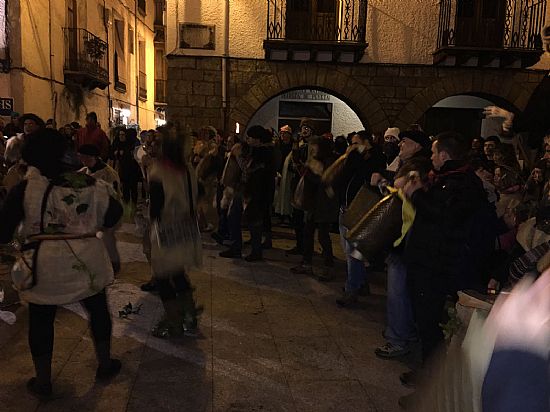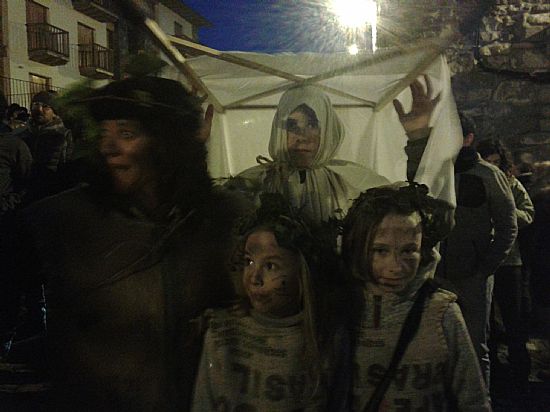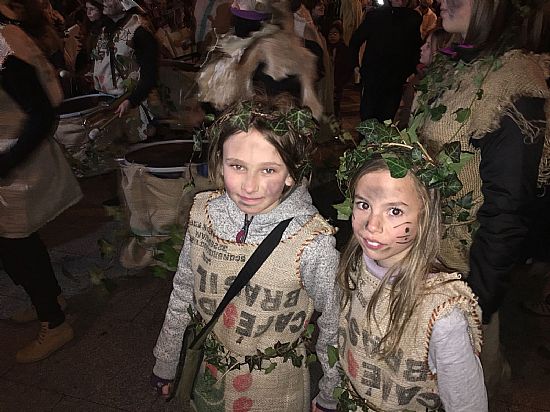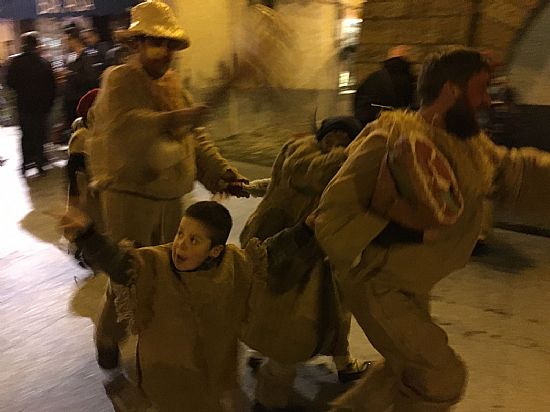Ansó, 29 January
by Isabel Isherwood - 21:37 on 31 January 2017
This has been a busy month in Ansó. Not only does Christmas not really happen until the 6th of January - when there is a parade through the streets, and the children’s presents are delivered by the three kings on camels - we have also had the village’s ‘small fiesta’ which celebrates the festivals of Saints Sebastian and Anton, and the Carnaval Bearnais, of which more below…..
The Fiestas Pequeñas took place in the week leading up to the 21st of January. It was a much smaller and more ‘local’ affair than the big fiesta in September, and the lead-up consisted mainly of an evidently ancient ritual to drive away bad spirits and protect the local herds. This involved the men of the village walking every street in the middle of the night, dressed in cow and sheep hides, ringing the most enormous cowbells I have ever seen. The kids all had a go too, in the late afternoon - Iona and Rowan only managed a few streets because of the cold and the loudness and heaviness of the bells! The final day saw a band playing, a theatre group performing, and a huge bonfire in the square; as the fire burned down people turned out with meat to barbecue and everyone ate together and drank too much wine. I heard people muttering that it is very ‘machista’, with only men being allowed to ring the cowbells, and the men who turn out to do the bell ringing being the more macho of the local guys….. But that aside it was a lovely, friendly event with a great sense of both community and tradition.

Then the following week – just last weekend – we had the Carnaval Bearnais. I am still struggling to work out exactly what this was all about. It is a cross-border event, in which bus-loads of usually somewhat inebriated French people from the Bearn region just over the Pyrenees descend on Ansó for twenty-four hours of music, drinking and crazy antics. The event is a celebration or re-enactment of the escape of and hunt for a character called Sent Pançard, who evidently did something he shouldn’t have in France (possibly involving one or both of pig-stealing and unacceptable carnaval-instigation), and fled to Spain (or the French coast, or possibly Portugal), where he was pursued, captured and possibly also executed. He is portrayed as a fat, big-nosed clown of a character with a string of sausages round his neck. Carnavals celebrating Sent Pançard happen all through the western Pyrenees in both France and Spain.

Here in Ansó, it was a colourful, bizarre, pythonesque, good natured and drunken event. Folk here dress up for Carnaval, but we are not talking Rio-style sequins and feathers - there are four different costume variants allowed: you can be a ghost, a bear, a cow/bull, or wear sacks and ivy (the significance of all of this was also lost on me…..!). As the Batucada (the drumming group I play with) was due to perform, we all dressed up, and the kids – who were taught two traditional Bearnais dances specially for the event – were also kitted out in sacks and cowhides.

The evening began with more of the bell-ringing, then cabezudos (huge-headed rather scary characters that terrorise the children) appeared, including a skeleton nearly four metres tall. Iona and Rowan, who are terrified of cabezudos, both retreated behind me and Iona got the ‘I hate this and am going to make sure everyone knows it’ look on her face…. and I could feel our chances of actually enjoying the evening slipping away. At this point, a particularly unpleasant cabezudo with purple hair and one cyclops-like eye managed to creep up behind us and gave Iona the fright of her life. She was reduced to tears, which had the unfortunate effect of making the cabezudo imitate her crying. However this evidently sparked some deep sense of injustice in Iona, who after hiding her face in my clothes for a few minutes suddenly turned round and gave the cabezudo a wallop. And then, somehow, everything was alright again, and most wonderfully of all, the cabezudos were no longer scary.

(NB - the cabezudo in this picture had been hijacked by some kids!)
There were some speeches in Bearnais and Ansotano, which we were unable to understand, but the gist of which was that Sent Pançard had escaped and was thought to be hiding out in Ansó, then flaming torches were produced from somewhere and the crowd gathered into a procession and began to make its way through town. Musicians played big white cowhide bagpipes and flutes and strange rectangular stringed instruments which are played by hitting the strings with a stick. And a troupe of fat men in padded sack outfits ran ahead through the streets hitting each other and passers-by with hams.

At various points the procession stopped and banged on the doors of houses, and a person would come out onto the balcony to deny that the fugitive was there. Eventually however Sent Pançard was discovered and taken to the Ayuntamiento (town hall is probably the best equivalent). What happened to him thereafter I do not know, but below in the square the bell-ringers were busy again, then the musicians played and the local kids including Iona and Rowan did their Bearnais dances, then the batucada got going. We played for nearly an hour and a half, dancing/marching through the village with the crowd following us; at each bar we passed we were plied with wine and beer and sausages (and at one blessed bar, cheese, to my very great delight!). The procession eventually wound up in the square where a bonfire was now burning, and a communal meal of migas (a local dish of shredded day-old bread, onion and bacon bits fried in olive oil) had been prepared.

The girls and I made it to about 11.30, but the festivities – or at least the drinking and general good cheer – continued well into the early hours. Jake, sadly, was in Indonesia and missed the fun.
We were told by several people when we first arrived that very little happens in Ansó, but for a community with only just over 400 permanent residents it seems to us to do pretty well. What is particularly lovely about this and the other fiestas we’ve experienced while being here is the combination of sense of community, deep-rooted and cherished tradition, and good plain fun.
Add your comment